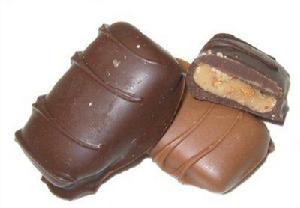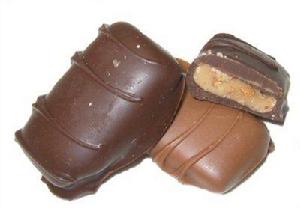Name
Toffee
Synopsis
 Toffee
ToffeeThe process of making toffee involves boiling the ingredients until the mix is stiff enough to be pulled into a shape which holds and has a glossy surface. The resulting mixture will typically be poured into a shallow tray and allowed to cool to form a sweet. Different mixes, processes, and (most importantly) temperatures of toffee making will result in different textures and hardnesses, from soft and often sticky to a hard brittle material.
A popular variant is English toffee, which is a very buttery toffee often made with almonds. It is available in both chewy and hard versions; there is some debate as to which is the traditional English style and which is an Americanized version. A popular presentation of English toffee is covered in chocolate and almond pieces. Heath bars are a readily-available candy made with English toffee.
Another variant is cinder toffee, also called honeycomb or sponge toffee, which is an aerated version with bubbles introduced by adding baking soda and vinegar while mixing. The baking soda and vinegar react to form carbon dioxide, which is trapped in the highly viscous mixture. In New Zealand this is called hokey pokey.
A particular application of toffee is in toffee apples, which are apples on sticks which are coated with toffee. Toffee apples are similar to taffy apples and caramel apples (both names for apples which are covered in caramel), but not the same as candy apples which are coated in cinnamon hard candy.
Owing to its sticky property, toffee has the capacity to pull loose dental fillings from teeth.
The origins of the word are unknown; The Oxford English Dictionary dates the first publication of the word to 1825, though there's little doubt that the sweet dates back further than that. (McGee, 1984 p. 410) claims it to be "from the Creole for a mixture of sugar and molasses" and that it entered the language early in the 19th century.
Related idiom
Toffee gives riseto a reasonably derisiveidiomin the BritishEnglish; it can be said of an incompetent person that they cannot do (whatever it is they cannot do) for toffee. In another slang phrase, to be "toffee-nosed" is to be condescending or aloof.

